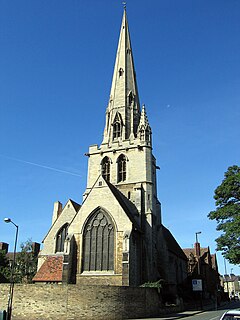All Saints, Jesus Lane
| All Saints', Jesus Lane | |
|---|---|

The church from the east, Jesus Lane
|
|
|
Location in central Cambridge
|
|
| General information | |
| Architectural style | Gothic Revival |
| Location | Jesus Lane |
| Town or city | Cambridge, England |
| Country | United Kingdom |
| Coordinates | 52°12′30″N 0°07′24″E / 52.208277°N 0.123231°E |
| Construction started | 1863 |
| Completed | 1870 |
| Design and construction | |
| Architect | G F Bodley |
All Saints' is a church on Jesus Lane in central Cambridge, England, which was built by the architect G F Bodley. The church was constructed between 1863 and 1870 and, as a notable example of the Gothic Revival style and the Arts and Crafts Movement, is a Grade I listed building. It is no longer a parish church, but has been under the care of The Churches Conservation Trust since 1981.
A mediæval church, All Saints in the Jewry, stood in St John's Street, Cambridge. Its history dates back to the 11th century and by the 13th century was in the patronage of St Radegund's Nunnery, later re-established as Jesus College. The church was rebuilt several times but by the nineteenth century was deemed too small for the growing congregation. It was finally demolished in 1865 to be replaced by a new building in Jesus Lane, at its junction with Manor Road. The churchyard of the original church is now an open space known as All Saints' Garden and contains a memorial cross designed by Basil Champneys in 1882.
Although it was initially hoped that George Gilbert Scott would design the new church. George Frederick Bodley who had been Scott's talented pupil, was chosen. The foundation stone was laid on 27 May 1863 and was consecrated on 30 November 1864. Between 1869 and 1871 the present tower and spire were added, with St Oswald's Church, Ashbourne, Derbyshire, used as the model.
The church fell out of use as a place of worship in 1973 and lay redundant for several years. A plan to demolish part of the building was abandoned in 1981. Today the church is used by the neighbouring theological college, Westcott House, for worship and for secular events, such as art exhibitions. It is open to the public daily.
...
Wikipedia

